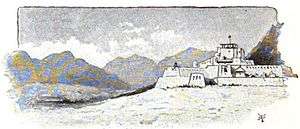Battle of Jamrud
| ||||||||||||||||||||||||||
The Battle of Jamrud was fought between the Emirate of Afghanistan and the Sikh Empire on 30 April 1837. The Sikhs were building up towards crossing the Khyber pass in order to invade Jalalabad. This led Afghan forces to confront the Sikh forces at Jamrud. The death of Sikh General Hari Singh Nalwa[2] limited the Khyber pass as the western extent of the Sikh Empire. By the time Sikh reinforcements had arrived,The garrison army was able to hold the Afghans.After the battle, Amir Dost Muhammad took up the title of "Commander of the Faithful."[3]
Background
The Battle of Jamrud was fought between the Sikhs under Maharajah Ranjit Singh and the Afghans under Emir Dost Muhammad Khan. Since the consolidation of the Sikh Empire in Punjab, Maharajah Ranjit Singh had turned the wave of invasions on Afghanistan. The Afghans had been losing their long held territories to Sikhs over the preceding years due to internal conflicts, and had seen their once mighty empire shrink with the loss of the Punjab region, Multan, Kashmir, Derajat, Hazara and Peshawar.
Prelude and Battle
Towards the end of 1836, Sardar Hari Singh Nalwa attacked and captured the small, though very strategic, fortified Misha Khel Khyberi village of Jamrud, situated on the south-side of a range of mountains at the mouth of the Khyber pass. With the conquest of Jamrud, the frontier of the Sikh Empire now bordered the frontier of Afghanistan.
In 1837, the Sikh army was in Lahore for the wedding of Kanwar Nau Nihal Singh, the grandson of Maharaja Ranjit Singh.The Emir of Afghanistan, Dost Muhammad Khan, accompanied by five of his sons, rushed with his army to drive the Sikhs out of Peshawar. The Sikh general Sardar Hari Singh Nalwa was killed in the battle. Many eyewitnesses claimed Nalwa ordered his under garments to be hung outside the fort before he died, discouraging the Afghans from attacking, believing Nalwa was still alive.[4]
Result of battle
The result of the battle is disputed amongst historians. Some contend the failure of the Afghans to take the fort as a victory for the Sikhs.[5] Whereas, some simply state an Afghan victory.[6] James Norris, Professor of Political Science at Texas A&M International University, states neither side could claim victory.[7]
See also
- Battle of Panipat (1761)
- Battle of Attock
- Battle of Multan
- Battle of Shopian
- Battle of Nowshera
- Battle of Peshawar (1834)
- Baba Deep Singh
References
- 1 2 Maharaja Ranjit Singh: A short life sketch, Ganda Singh, Maharaja Ranjit Singh: First Death Centenary Memorial, (Nirmal Publishers, 1986), 43.
- ↑ http://www.harisinghnalwa.com/index.html
- ↑ Frank Clements, Conflict in Afghanistan: A Historical Encyclopedia, He also defeated the Sikhs at the Battle of Jamrud in 1837 and took on himself the title of "Commander of the Faithful.", p. 74
- ↑ Chief and families of Note in Punjab, Vol II, op.cit., pp. 87,89,90
- ↑ 1. Bikrama Jit Hasrat, Life and times of Ranjit Singh, p137;"The doubtful Sikh victory at Jamrud in 1837 had made it clear to Ranjit Singh that policy of hatred and repression in the northwestern frontier so far pursued had failed in its objective."
2. Paddy Docherty, The Khyber Pass: A History of Empire and Invasion (Faber and Faber, 2007), 186–187.
3. India and the North-West Frontier: The First Afghan War, Edward Ingram, Great Powers and Little Wars: The Limits of Power, ed. A. Hamish Ion and Elizabeth Jane Errington, (Praeger Publishers, 1993), 44; "The second was Peshawar, which controlled the entry to the Khyber Pass and had been seized in 1834 by Ranjit Singh from Dost Mohammed, Who tried in 1837 to get it back but lost his chance at the Battle of Jamrud." - ↑ 1. Jeffery J. Roberts, The Origins of Conflict in Afghanistan, p4;"In 1837 Dost's son, Akbar Khan, led an Afghan army to victory at Jamrud. Akbar, however, did not followup his success with an advance to Peshawar, and the city remained in Sikh hands."
2. Zalmay Ahmad Gulzad, The history of the delimitation of the Durand Line development of the Afghan State (1838-1898), (University of Wisconsin--Madison), p62;"1837 they fought a pitched battle at Jamrud in which the Afghan forces were victorious."
3. Frank Clements, Conflict in Afghanistan: A Historical Encyclopedia, (ABC-CLIO, 2003), 74; "He also defeated the Sikhs at the Battle of Jamrud in 1837 and took on himself the title of "Commander of the Faithful." - ↑ James A. Norris, First Afghan War: 1838-42, (Cambridge University Press), p109;"At the battle of Jamrud neither side could honestly claim a victory, but the Sikhs suffered severely at the hands of the Afghan horsemen, and they lost one of their king's favorite generals, Hari Singh."
